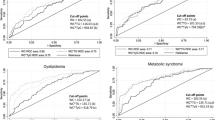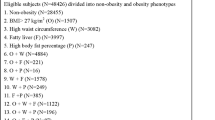Abstract
Increased waist circumference (WC) and related anthropometric indices have been shown to be, independently of body weight and body mass index (BMI), associated with adverse metabolic traits in many populations. It is unknown, however, whether WC also predicts adverse metabolic traits in severely obese subjects displaying a BMI greater than 35 kg/m2. To address this question, we analyzed a dataset including 838 severely obese patients (597 women, BMI 44.6 ± 6.2 kg/m2; 241 men, BMI 44.3 ± 5.7 kg/m2). Body weight, height, WC, hip circumference, and blood pressure were measured in all subjects along with the following metabolic blood markers: fasting glucose, insulin, glycolized hemoglobin levels, triglycerides, total cholesterol, low- and high-density cholesterol, and uric acid. Multivariate regression analyses indicated that WC as well as related anthropometric indices, in particular those accounting for subjects’ height, were associated with many metabolic variables independently of body weight and BMI. In general, height-adjusted WC indices were more closely associated with metabolic traits in women than in men. Collectively, our findings suggest that body fat distribution also plays an important role in determining metabolic traits in severely obese subjects and that WC represents a valuable marker of abdominal/visceral obesity in this population.

Similar content being viewed by others
References
Pischon T, Boeing H, Hoffmann K, et al. General and abdominal adiposity and risk of death in Europe. N Engl J Med. 2008;359:2105–20.
World Health Organization. Obesity: preventing and managing the global epidemic. Report of a WHO consultation. 2000. http://whqlibdoc.who.int/trs/WHO_TRS_894.pdf.
WHO. Physical status: the use and interpretation of anthropometry. Report of a WHO expert consultation. Geneva: World Health Organization (WHO); 1995.
Arora S. Surrogate markers of insulin resistance: a review. World J Diabetes. 2010;1:36–47.
Amato MC, Guarnotta V, Giordano C. Body composition assessment for the definition of cardiometabolic risk. J Endocrinol Invest. 2013;36:537–43.
Osama H, Sriurai P, Ebaa AO. Metabolic obesity: the paradox between visceral and subcutaneous fat. Curr Diabetes Rev. 2006;2:367–73.
Bosello O, Zamboni M. Visceral obesity and metabolic syndrome. Obes Rev. 2000;1(1):47–56.
Jacobs EJ, Newton CC, Wang Y, et al. Waist circumference and all-cause mortality in a large US cohort. Arch Intern Med. 2010;170(15):1293–301.
Leitzmann MF, Moore SC, Koster A, et al. Waist circumference as compared with body-mass index in predicting mortality from specific causes. PLoS One. 2011;6(4):e18582.
Guallar-Castillón P, Balboa-Castillo T, López-García E, et al. BMI, waist circumference, and mortality according to health status in the older adult population of Spain. Obesity (Silver Spring). 2009;17(12):2232–8.
Bajaj HS, Brennan DM, Hoogwerf BJ, et al. Clinical utility of waist circumference in predicting all-cause mortality in a preventive cardiology clinic population: a PreCIS Database Study. Obesity (Silver Spring). 2009;17(8):1615–20.
Kanaya AM, Vittinghoff E, Shlipak MG, et al. Association of total and central obesity with mortality in postmenopausal women with coronary heart disease. AM J Epidemiol. 2003;158(12):1161–70.
Bigaard J, Tjønneland A, Thomsen BL, et al. Waist circumference, BMI, smoking, and mortality in middle-aged men and women. Obes Res. 2003;11(7):895–903.
Chan DC, Watts GF, Barrett PH, et al. Waist circumference, waist to hip ratio and body mass index as predictors of adipose tissue compartments in men. QJM. 2003;96:441–7.
Bennasar-Veny M, Lopez-Gonzalez A, Tauler P, et al. Body adiposity index and cardiovascular health risk factors in Caucasians: a comparison with the body mass index and others. PLoS. 2013;8(5):e63999.
Browning LM, Hsieh SD, Ashwell M. A systematic review of waist-to-height ratio as a screening tool for the prediction of cardiovascular disease and diabetes: 0.5 could be a suitable global boundary value. Nutr Res Rev. 2010;23(2):247–69.
Ashwell M, Gunn P, Gibson S. Waist-to-height ratio is a better screening tool than waist circumference and BMI for adult cardiometabolic risk factors: systematic review and meta-analysis. Obes Rev. 2012;13:275–86.
Ho SY, Lam TH, Janus ED, Hong Kong Cardiovascular Risk Factor Prevalence Study Steering Committee. Waist to stature ratio is more strongly associated with cardiovascular risk factors than other simple anthropometric indices. Ann Epidemiol. 2003;13:683–91.
Hsie SD, Yoshinaga H, Muto T. Waist-to-height ratio, a simple and practical index for assessing central fat distribution and metabolic risk in Japanese men and women. Int J Obese Relat Metab Disord. 2003;27:610–6.
Bosy-Westphal A, Danielzik S, Geisler C, et al. Use of height3:waist circumference3 as an index for metabolic risk assessment? Br J Nutr. 2006;95:1212–20.
World Health Organization. Obesity. Preventing and managing the global epidemic. Report of a WHO consultation on obesity, Geneva 3–5 June 1997. Geneva: World Health Organization; 1998.
Matthews DR, Hosker JP, Rudenski AS, et al. Homeostasis model assessment: insulin resistance and beta-cell function from fasting plasma glucose and insulin concentrations in man. Diabetologia. 1985;28(7):412.
Acknowledgments
Financial and material support was given by the Kantonsspital St. Gallen.
Conflict of Interest
None of the authors has a conflict of interest to the study.
Author information
Authors and Affiliations
Corresponding author
Rights and permissions
About this article
Cite this article
Zazai, R., Wilms, B., Ernst, B. et al. Waist Circumference and Related Anthropometric Indices Are Associated with Metabolic Traits in Severely Obese Subjects. OBES SURG 24, 777–782 (2014). https://doi.org/10.1007/s11695-013-1141-6
Published:
Issue Date:
DOI: https://doi.org/10.1007/s11695-013-1141-6




